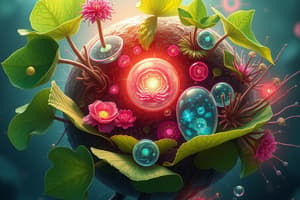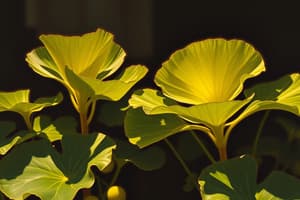Podcast
Questions and Answers
What is the overall goal of the Calvin cycle?
What is the overall goal of the Calvin cycle?
use carbon dioxide gas and energy to produce carbohydrates.
Where does the energy input to reduce 3PG molecules in the Calvin cycle come from?
Where does the energy input to reduce 3PG molecules in the Calvin cycle come from?
ATP and NADPH that were supplied through the light reactions.
The last stage of the Calvin cycle acts to recycle ______, sending it back to aid in _______ again.
The last stage of the Calvin cycle acts to recycle ______, sending it back to aid in _______ again.
RuBP; carbon fixation
How can light from the sun be best described?
How can light from the sun be best described?
Photosynthetic organisms use a limited portion of the electromagnetic spectrum of light. This portion is called ______ light and consists of wavelengths of light from about 400 to 740 nm.
Photosynthetic organisms use a limited portion of the electromagnetic spectrum of light. This portion is called ______ light and consists of wavelengths of light from about 400 to 740 nm.
The chloroplasts house the structures required for photoautotrophs like plants to undergo photosynthesis.
The chloroplasts house the structures required for photoautotrophs like plants to undergo photosynthesis.
Which choice(s) correctly match(es) the reaction to the structure in which it takes place?
Which choice(s) correctly match(es) the reaction to the structure in which it takes place?
The Calvin cycle reactions, which take place in the stroma, are responsible for the synthesis of glucose.
The Calvin cycle reactions, which take place in the stroma, are responsible for the synthesis of glucose.
The process by which light energy is converted to chemical energy begins in the _______.
The process by which light energy is converted to chemical energy begins in the _______.
Photosystem I occurs before photosystem II during the light reactions.
Photosystem I occurs before photosystem II during the light reactions.
What can a photosystem best be described as?
What can a photosystem best be described as?
Why does photosystem II not lose all its electrons over time?
Why does photosystem II not lose all its electrons over time?
What is the carbohydrate product that exits the Calvin cycle?
What is the carbohydrate product that exits the Calvin cycle?
It takes ____________ rounds of the Calvin cycle reactions to allow one molecule of G3P to exit for making carbohydrates.
It takes ____________ rounds of the Calvin cycle reactions to allow one molecule of G3P to exit for making carbohydrates.
G3P can be metabolized into ____________ , which can be combined with fructose to form ____________.
G3P can be metabolized into ____________ , which can be combined with fructose to form ____________.
Glucose phosphate is also the starting point for the complex carbohydrates ____________ and cellulose.
Glucose phosphate is also the starting point for the complex carbohydrates ____________ and cellulose.
The Calvin cycle reactions of photosynthesis occur in the ______ of chloroplasts.
The Calvin cycle reactions of photosynthesis occur in the ______ of chloroplasts.
Plants that have evolved to be successful in hot, dry conditions carry out ____________ photosynthesis instead of ____________ photosynthesis.
Plants that have evolved to be successful in hot, dry conditions carry out ____________ photosynthesis instead of ____________ photosynthesis.
In this type of photosynthesis, the first detectable molecule following carbon dioxide ____________ is a molecule composed of ____________ carbon atoms.
In this type of photosynthesis, the first detectable molecule following carbon dioxide ____________ is a molecule composed of ____________ carbon atoms.
In C₄ plants, the Calvin cycle occurs only in the ____________ cells.
In C₄ plants, the Calvin cycle occurs only in the ____________ cells.
C₄ plants thrive in hot, dry climates where their ____________ close, which prevents rubisco from being exposed to oxygen.
C₄ plants thrive in hot, dry climates where their ____________ close, which prevents rubisco from being exposed to oxygen.
In moderate climates, C₃ plants ordinarily have the ____________ over C₄ plants.
In moderate climates, C₃ plants ordinarily have the ____________ over C₄ plants.
Study Notes
Calvin Cycle Overview
- The Calvin cycle utilizes carbon dioxide and energy to synthesize carbohydrates.
- The first stage produces 3PG molecules, requiring energy input for reduction.
Energy Input
- The energy required in the Calvin cycle comes from ATP and NADPH generated in the light reactions.
Recycling RuBP
- The last stage of the Calvin cycle recycles RuBP, facilitating continuous carbon fixation.
Light Characteristics
- Sunlight exhibits both wave and particle properties.
- Photosynthetic organisms utilize visible light (400-740 nm) from the electromagnetic spectrum.
Chloroplast Structure
- Chloroplasts contain stroma and thylakoids, crucial for photosynthesis in photoautotrophs like plants.
Reaction Locations
- Light-dependent reactions occur in thylakoids; the Calvin cycle occurs in the stroma.
- Calvin cycle reactions are responsible for glucose synthesis.
Photosystem Functions
- Light energy conversion begins in thylakoids; Photosystem II operates before Photosystem I.
- A photosystem is defined as a pigment collection that captures solar energy, directing it to reaction centers.
Water Splitting and Electron Supply
- Photosystem II's electrons are replenished by splitting water molecules, preventing depletion.
G3P Production
- G3P is the carbohydrate product of the Calvin cycle and requires three cycles for one molecule to exit.
Metabolism of G3P
- G3P can be converted into glucose phosphate, which combines with fructose to form sucrose.
- Glucose phosphate is also a precursor for starch and cellulose.
Photosynthesis Conditions
- The Calvin cycle occurs in the stroma of chloroplasts.
- C4 photosynthesis is more advantageous in hot, dry conditions compared to C3 photosynthesis.
Carbon Fixation in C4 Plants
- Upon carbon dioxide fixation in C4 plants, a four-carbon molecule is the first product.
- The Calvin cycle in C4 plants is restricted to bundle sheath cells.
Adaptations to Climate
- C4 plants adapt to hot, dry climates by closing stomata to prevent rubisco exposure to oxygen.
- In moderate climates, C3 plants generally have advantages over C4 plants.
Studying That Suits You
Use AI to generate personalized quizzes and flashcards to suit your learning preferences.
Description
Explore the Calvin cycle and its role in photosynthesis. Understand how energy input from ATP and NADPH aids in synthesizing carbohydrates and the importance of chloroplast structure. This quiz covers the stages of the Calvin cycle, light reactions, and the characteristics of sunlight.




